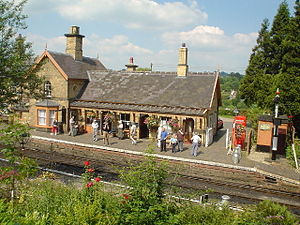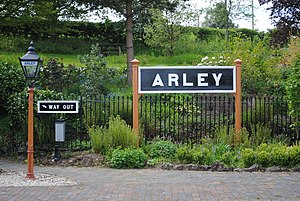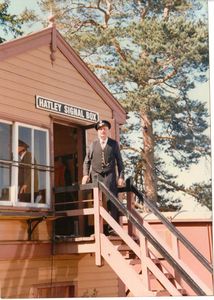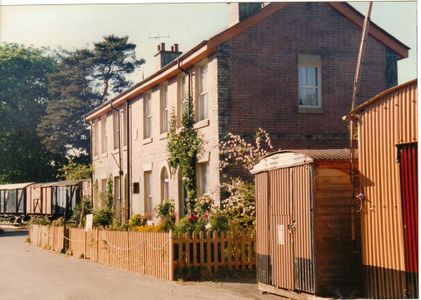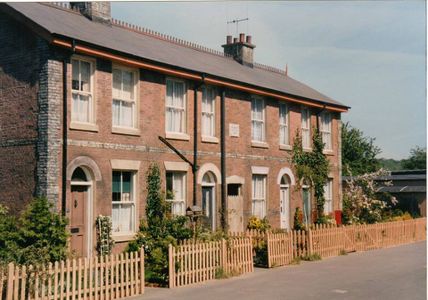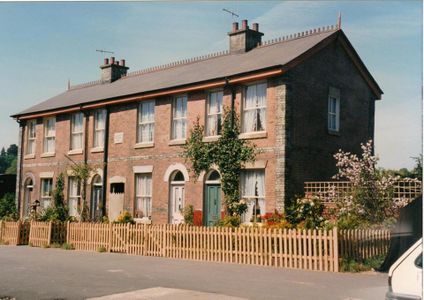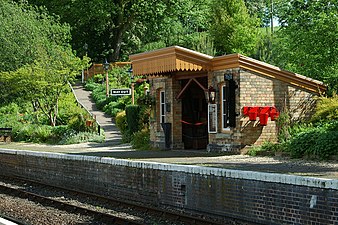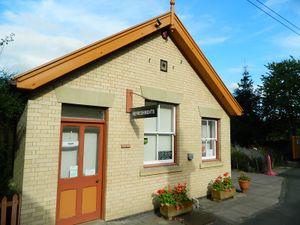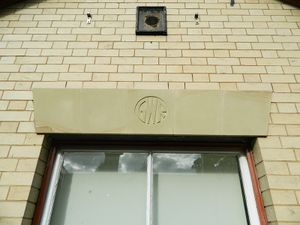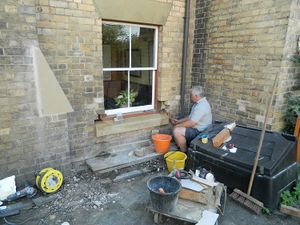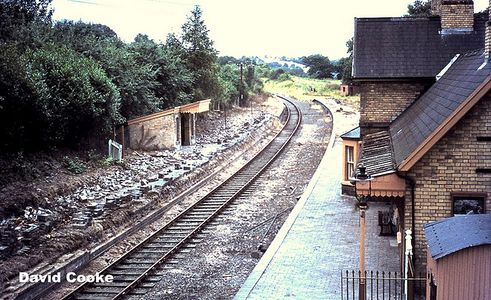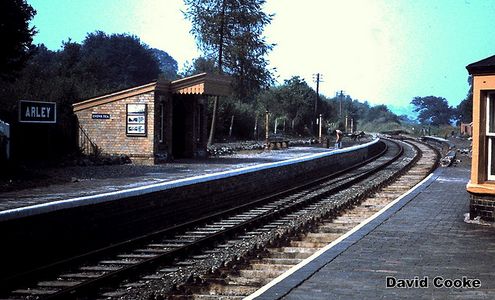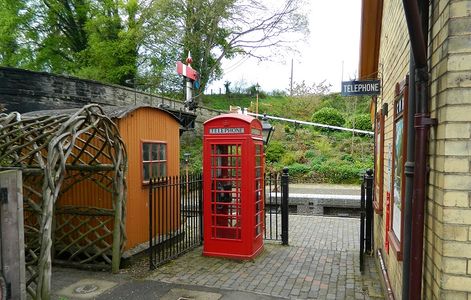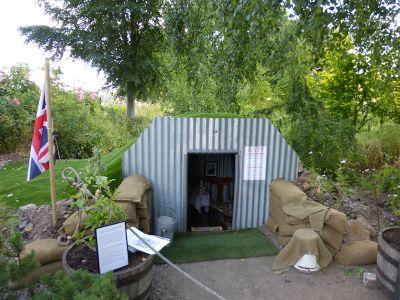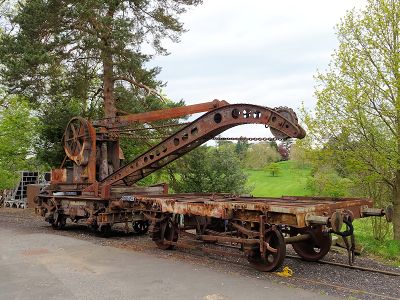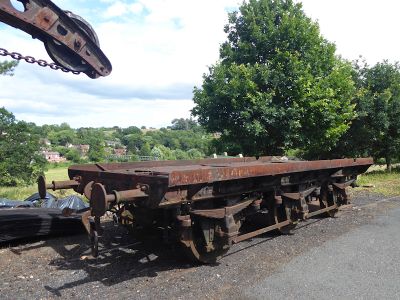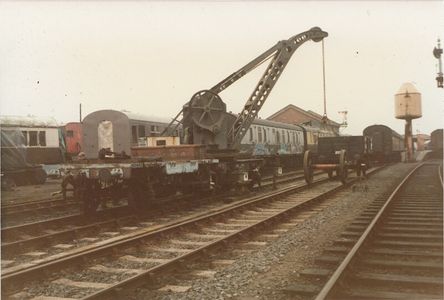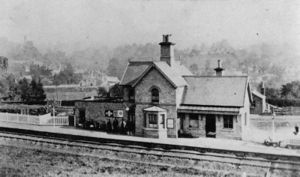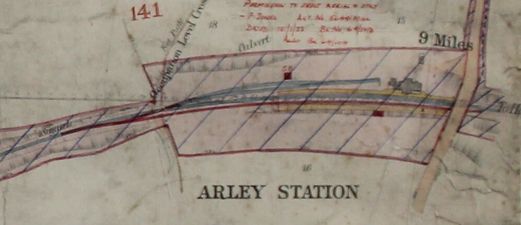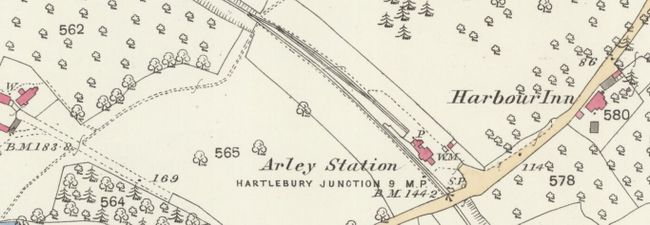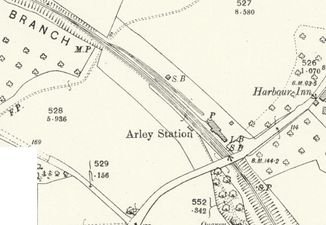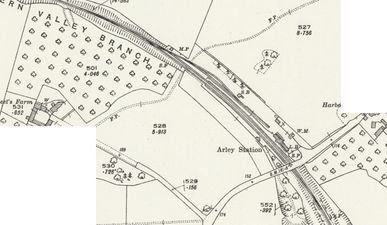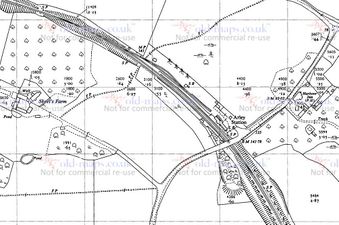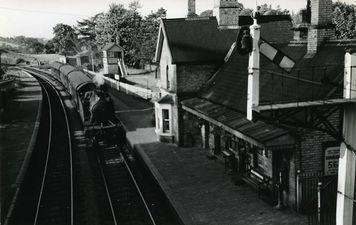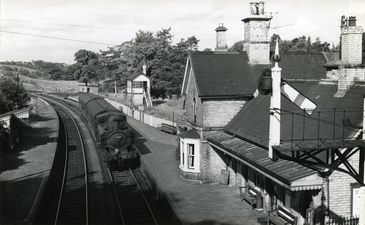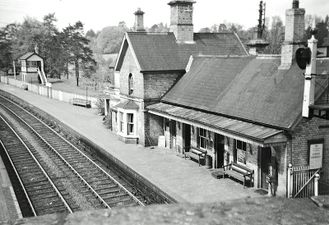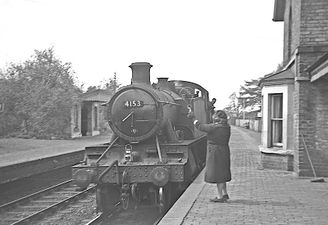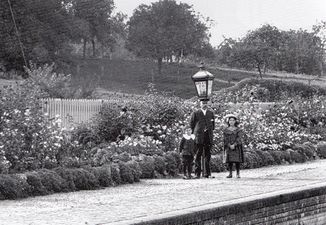Arley
| Up (towards Kidderminster) | Down (towards Bridgnorth) |
|---|---|
| Bewdley (3¾ miles) via Northwood Halt |
Highley (2¼ miles) |
Contents
The station
Arley station has two platforms and a signal box, allowing trains travelling in opposite directions to pass.
Barrow crossings are located at both ends of the platforms, but may not be used by the general public. Bridge 17 is located at the south end of the station, immediately south of the barrow crossing, and is the main passenger route between the platforms. Skeet's Farm crossing is also located in the station area, immediately north of the goods yard.
During periods of lighter traffic, when Arley signal box is switched out, all trains use the platform adjacent to the main station building.
From January to Easter 2011 the SVR's winter works dealt with severe damage at Arley due to ground movement caused by failed drainage, in turn occasioning track twist. The Up platform was rebuilt, drainage installed and track relaid at a cost of £367,000.[1][2]
In February 2017 the waiting room at Arley Station became licensed to hold civil marriages and partnerships, with space for up to 21 people. Further information on the SVR's wedding packages may be found on the SVR website Weddings page.
Arley was until 2018 also the site of Santa's Grotto for the Santa Special services. From 2020 it hosted the plays that formed part of the SVR's Christmas services.
Arley village
The village itself is named Upper Arley (also historically Over Arley[3][4]), which differentiates it from the similarly named, but differently spelled Areley Kings less than six miles away near Stourport.
Until 1895 Arley, including the railway, was part of a narrow neck of Staffordshire bounded on three sides by Shropshire and Worcestershire until it was moved to Worcestershire[5][6].
Photos at Arley, showing station building, signalbox & gardens
Facilities
Arley station does not have a public car park.
There is a small café building behind the station, known from 2024 as The Weighbridge Tea Room at Arley Station, which serves hot and cold drinks and snacks. It was sometimes referred to as Tom's Cabin, after an earlier building. It remained closed after the 2020 coronavirus disease (COVID-19) pandemic until reopened in time for the 2023 Spring Steam Gala by station volunteers.
The Arley Station Fund has a shop next to the refreshment kiosk in the station yard.
Film and TV productions filmed at Arley
Several film and TV productions have scenes from, or filmed at, Arley. The station has temporarily carried other identities for filming purposes, including:
- Candleshoe 1977 (Hambleden)
- Silver Blaze 1977 (Tavistock)
- The Good Soldier 1981 (Branshaw)
- L For Lester 1982 (Barrow Gurney)
- The Box Of Delights 1984 (Condicote)
- A Wreath of Roses 1987 (Hampton, for which a dummy footbridge connected platforms 1 and 2)
- The Halt 1987 (Newton Halt)
- Oh Doctor Beeching! 1995-97 (Hatley, see below)
- Goodnight Mister Tom 1998 (Weirwold)
- Enola Holmes 2020 (Ferndell)
Oh Doctor Beeching!
(See main article)
A BBC TV sitcom ran from 1995 to 1997, set in the small fictional branch line railway station of Hatley. Filming took place at Arley.
A row of Victorian railway cottages was built in the yard as a film prop. After final filming the cottages were dismantled and retained, but despite reminders to the BBC about what they wanted with them they gave no response. Ultimately they were broken up with the assistance of the Junior Club.
The garden on the main platform by the Gents WC was created by the BBC and is known today as the BBC garden.
The signalbox had a name plate above the door.
Points of interest
Station buildings
The main station building at Arley dates from the opening of the Severn Valley Railway in 1862. The station was considerably smaller than it is now, passenger facilities being limited to the present waiting room with a partitioned booking office in the corner of the room and the gentlemen's toilets. Facilities were completed by a weighbridge on the site of the present day refreshment kiosk in the station yard. Extensions were later added, consisting of a Ladies' waiting room authorised in 1892 and an additional bedroom in the Station Master’s house added in 1901.
From opening, there was no passing loop and the single platform was very much shorter than the two the station has today. If you look at the face of the main platform from the down platform (or garden side) it is possible to see the shape of the original short, stone-faced platform which you can see was also more than a foot lower than the one in use now. The passing loop and a signal box were installed in 1883 together with a second platform, the existing platform being raised and lengthened. The shelter on Platform 2 is also original, dating from the opening. In 1907 both the platforms were further lengthened, since then the only significant change to the layout was the laying of a second siding behind the signal box sometime before the 1930s.
The café building behind the station was built during the summer of 1992 on the site of the former weighbridge. It replaced a similar building known as 'Tom’s Cabin' (named after volunteer Tom McGee who ran the cabin and did much restoration at Arley over many years) that had become dangerous.
In 2016, a number of stone sills, coping stones and quoins were replaced.
During maintenance works in 2023 volunteers uncovered the old water pump beside the station building, believed to have been manufactured by Joseph Evans of Wolverhampton. Reportedly Mrs Jones was still using this pump for the house water when the early preservationists first came to Arley.[7]
In 2018 an SVRA raffle raised over £7,000 for new facilities including a workshop and storage for Santa equipment to replace a small corrugated metal shed next to the gift shop.[8] In late 2019 construction started on the new building at the north end of the station, with the roof coming from part of the old Bewdley platform canopy. It was also partly funded by the Arley Station Fund[9].
Restoration
By 1972 the restoration had begun in earnest with much vegetation clearance, platform repairs, mains water and electricity installed for the first time, GWR gas lamps erected and new running-in boards erected. A summer camp school party gathered up the surfacing bricks on the down platform to facilitate its levelling and re-laying. The station was repainted in the early 1930s GWR style.
By spring 1973 the platform awning had been repaired, the former weighbridge converted into 'Sid’s Café' and the future car park to the rear of the down platform levelled. Further work saw the painting of the toilets and installation of new sinks, work in the gardens and the opening of the station shop.
After closure to passenger trains, BR lifted the Up loop (the running line nearer the station building) through the station and the sidings, and the down platform edging was removed to ensure clearance for the coal trains which still passed through until 1969. When the SVR first re-opened the line between Hampton Loade and Bewdley in 1974, there was therefore no facility to pass trains. This was re-laid over the next year and re-opened on 25 May 1975.
Telephone kiosk
The telephone kiosk on Platform 1, which can be seen in the main picture above, was acquired from the P.O. in Birmingham circa late 1981, having been vandalised ‘beyond economic repair’[10]. Once at Arley it was duly repaired, and within a year had been returned to full working order[11].
Anderson shelter
An Anderson shelter was erected in the picnic garden in 2018, where it could be seen during that year’s ‘Step Back to the 1940s’ weekends. More than 3.5 million of these shelters were issued to the public before and during World War II to provide shelter from bombs and shrapnel. This particular example was originally installed at a house in Weoley Castle, Birmingham, and was donated to the SVR by Lisa Priest of Birmingham City Council and Mrs Dorothy Sigures of Weoley Castle.[12][13]
GWR 446 6 ton hand crane
GWR 446 6Ton Hand Crane is stabled with GWR 2501 'Rotank' 6-Wheeled Road Milk Tank Flat Wagon which arrived in July 2021 to replace the former Crane Runner 707261, 2501 being considered better suited to the crane.[14] The crane and flat wagon will undergo cosmetic restoration.
Station masters
Station masters at Arley since preservation have been as follows:
- C.P. May (1974-1975)
- Barrie Geens (1975-1983)
- Ian Latimer (1983- )
Arley history before preservation
- 1862: Arley station opened with the rest of the Severn Valley Line on 1 February, but had only one platform and no facility for crossing trains. Control of train movements was by single needle telegraph only
- 1883: A second platform, authorised in August 1882, was brought into use in June 1883. Installation of a signal box and interlocking of points and signals were completed around this time.
- 1891: 'Train staff and ticket' working in conjunction with a single-needle block telegraph was introduced throughout the line, replacing the earlier simple telegraph working arrangements. Henceforth drivers could not enter a section without possession of a physical staff, or a paper ticket stating the staff would follow on a succeeding train. Those used at Arley were for Arley to Bewdley North (hexagonal staff, yellow ticket) and Arley to Hampton Loade (square staff, red ticket). The 1893 Working Timetable noted that the persons authorised to exchange the staff and ticket were the Station Inspector J. Pugh (see below) and the Porter-Signalman on late duty.
- 1894: ‘Electric staff’ working replaced staff and ticket working. Highley also became a staff station, breaking the long section to Hampton Loade.
- 1898: An accident occurred when a train overran signals when entering the station and was derailed.
- 1907: The platforms were lengthened and the up platform widened.
- 1913: Following the building of a signal box at Kinlet and Billingsley Sidings, Arley to Kinlet (when switched in) was worked by electric staff but Arley to Highley was worked by electric tablet, probably Tyers No 7.
- 1922: GWR staff records show the station had a staff of 3, comprising the stationmaster and two signalmen.
- 1938: A GWR camping coach was based at Arley.
- 1950: By this date, Electric Train Token working had been introduced, becoming the fifth method of train control.
- 1960: The loop capacity, for the purpose of crossing trains, was 27 wagons, plus engine and brake van.[15]
- 1963: Through passenger services ceased on 9 September, with through freight services ending at the end of November.
- 1964: The signal box closed on 28 June. The up line and sidings were lifted, and the edge of the down platform was removed to give greater clearance for coal trains from Alveley. The original signal box was later demolished by SVR volunteers, and parts used to reinstate Bridgnorth signal box in 1969.[16]
Early Station Masters at Arley
The first description of 'Station Master' in GWR records is in 1897.
| Name | Born | From | To | Comments |
|---|---|---|---|---|
| Samuel Allard | 1820, Great Creeton, Northamptonshire | August 1863 | September 1865 | Joined West Midland Railway February 1852. Booking Constable at Buildwas (1865 - 1866). Retired 1897. |
| William Pearson | 1835, Stratford upon Avon, Warwickshire | September 1865 | Retired ca.1885 | Died 7 March 1886. |
| Joseph Pugh | 28 September 1830, Stoke Prior, Worcestershire | January 1886 | Resigned October 1900 | Joined West Midland Railway December 1855. Formerly Booking Porter at Linley (1864 - 1880) Described as Station Inspector in the 1893 WTT (see above). |
| George Batchelor | 1 April 1860, Honeybourne, Worcestershire | 20 October 1900 | Retired 1920? | Formerly Signalman at Hartlebury (1882) and Kidderminster (1887). Died 23 December 1942. |
| Joseph Thomas Hill | 5 April 1877, Kinver, Staffordshire | 1920? | Before 1932 | Formerly Porter at Bewdley (1896), Signal Porter at Hampton Loade (1897) and Bridgnorth (1899) and Station Master at Hampton Loade (1915?). Transferred to Fernhill Heath in the early 1930s. Died July 1943. |
George Batchelor and Joe Hill both won numerous awards for the gardens at Arley. Joe Hill was the last resident Station Master; after he left the station came under the supervision of Bewdley and the house was occupied by Fred Jones and his wife Diane who both served as Porter/signalman. Their son David became a fireman and regularly worked on the line, exchanging tokens with his mother for the last time on the final passenger train to run on the branch on 7 September 1963.[17] After closure, the station house was still the home of Mr and Mrs Jones, who had staffed the station for many years.
Traffic statistics
| Passenger Traffic | Freight Traffic | |||||
|---|---|---|---|---|---|---|
| Year | Tickets issued | Parcels dispatched | Revenue (£) | Tons received & despatched | Revenue (£) | Total revenue (£) |
| 1903 | 17,295 | 2,453 | 914 | 881 | 178 | 1,092 |
| 1913 | 15,796 | 3,219 | 761 | 1,399 | 301 | 1,062 |
| 1923 | 12,898 | 1,341 | 862 | 1,828 | 996 | 1,858 |
| 1933 | 8,663 | 997 | 477 | 54 | 47 | 524 |
| 1938 | 11,623 | 926 | 526 | 44 | 24 | 550 |
| 1942 | 17,119 | X | 1,144 | 159 | X | X |
| 1947 | 16,030 | 757 | 1,136 | 101 | X | X |
| 1952 | 11,769 | 763 | 834 | (a) | X | X |
X: Information not recorded
(a): Information recorded under Bewdley
Historic maps of Arley station
- GWR plan of Arley station showing the original single line with later amendments in red
- 1885 OS map (survey date 1883) showing the single line through the station
- 1904 OS map showing the passing loop and second platform opened in June 1883
- 1927 OS map showing the 1907 extensions to both platforms
- 1960 OS map showing no significant changes in over 30 years
- 1905 GWR schematic plan of Arley giving siding capacities and other details.
Gallery
An ex-GWR Prairie calls at Arley in October 1959 (Sellick Collection)
Pannier 3619 calls at Arley in September 1962 (Sellick Collection)
See also
References
Arley station history on www.svrlive.com
- ↑ Railway Magazine September 2010
- ↑ SVR(H) Report and Accounts for year ending 31 December 2011, page 3.
- ↑ Handbook to the Severn Valley Railway, by J. Randall 1863
- ↑ 1579 map of Shropshire on the Shropshire Star web site
- ↑ "Parishes: Upper Arley", British History Online (Retrieved 12 December 2019)
- ↑ Upper Arley, UK and Ireland Geneology) (Retrieved 12 December 2019)
- ↑ Arley Station Facebook page, 6 March 2023 (Retrieved 24 April 2023)
- ↑ SVR News 200
- ↑ Express Points, February 2020 (Retrieved 4 February 2020)]
- ↑ SVR News 62
- ↑ SVR News 66
- ↑ Information board next to the shelter
- ↑ Anderson shelter on Wikipedia
- ↑ SVR Wagons Facebook 13 January 2019
- ↑ Sectional Appendix to the Working Time Tables and Books of Rules and Regulations, Birmingham Traffic District, October 1960
- ↑ Marshall (1989), p. 200.
- ↑ Geens (1985) p. 18.
Links
- SVR Wedding packages
- Arley Station Facebook page.
- The Weighbridge Tea Room at Arley Station Facebook page.
- Arley Railway Station Facebook page.
| ||||||||||||||||||||
